Untitled - Link 1 Link 16 Link 2 Link 17 Link 3 Link 18 Link 4 Link 19 ...
Untitled - Link 1 Link 16 Link 2 Link 17 Link 3 Link 18 Link 4 Link 19 ...
Untitled - Link 1 Link 16 Link 2 Link 17 Link 3 Link 18 Link 4 Link 19 ...
Create successful ePaper yourself
Turn your PDF publications into a flip-book with our unique Google optimized e-Paper software.
22 Osseointegration and Dental Implants<br />
5-year rates of framework fracture of 0.7%<br />
and 1.6%, respectively. For implant-supported<br />
SCs the fracture of the crown framework<br />
(coping) was reported in seven studies,<br />
and its annual complication rate was 0.61,<br />
translating into a 5-year rate of framework<br />
fracture of 3.0%. This technical complication<br />
was signifi cantly higher (p = 0.0<strong>16</strong>) in studies<br />
reporting on all-ceramic crowns.<br />
The second most common technical complication<br />
was abutment or occlusal screw<br />
loosening. In a Poisson-model analysis, the<br />
annual complication rates were 1.15 for<br />
implant-supported FDPs, 1.44 for combined<br />
tooth-implant-supported FDPs, and 2.72 for<br />
implant-supported SCs, translating into 5year<br />
rates of abutment or occlusal screw loosening<br />
of 5.6% for implant-supported FDPs,<br />
6.9% for combined tooth-implant-supported<br />
FDPs, and 12.7% for implant-supported SCs<br />
(Table 1.6). In this repect one study (Henry<br />
et al. <strong>19</strong>96), reporting on the fi rst generation<br />
of single crowns on Brånemark implants, was<br />
a clear outlier. If this study is excluded from<br />
the analysis, the cumulative incidence of<br />
screw loosening decreases to 5.8%.<br />
Loss of the screw access hole restoration<br />
was reported only in one study (Örtorp and<br />
Jemt <strong>19</strong>99). This occurred in 8.2% of the<br />
anchors.<br />
Another technical complication was the<br />
loss of retention. From 753 FDPs analyzed,<br />
this complication occurred in 45 of the reconstructions.<br />
The annual complication rates<br />
were 1.<strong>18</strong> for implant-supported FDPs, 1.53<br />
for combined tooth-implant-supported FDPs,<br />
and 1.13 for implant-supported SCs, translating<br />
into 5-year rates of loss of retention of<br />
5.7% for implant-supported FDPs, 7.3% for<br />
combined tooth-implant-supported FDPs,<br />
and 5.5% for implant-supported SCs (Table<br />
1.6). Two studies reporting on the same<br />
cohort of patients (Brägger et al. 2001, 2005)<br />
evaluated loss of retention. The cumulative<br />
incidence was 2.9% after 5 years but increased<br />
to <strong>16</strong>.0% after 10 years.<br />
Fractures of components such as implants,<br />
abutments, and occlusal screws were rare<br />
complications. Out of 3,611 implants ana-<br />
lyzed, 21 abutments and occlusal screws<br />
fractured. The annual complication rates<br />
were 0.30 for implant-supported FDPs, 0.11<br />
for combined tooth-implant-supported FDPs,<br />
and 0.07 for implant-supported SCs, translating<br />
into 5-year rates of abutment and occlusal<br />
screw fractures of 1.5% for implantsupported<br />
FDPs, 0.6% for combined toothimplant-supported<br />
FDPs, and 0.35% for<br />
implant-supported SCs (Table 1.6).<br />
Out of 4,401 implants analyzed, 21 fractured.<br />
The annual failure rates were 0.11 for<br />
implant-supported FDPs, 0.20 for combined<br />
tooth-implant-supported FDPs, and 0.03 for<br />
implant-supported SCs, giving 5-year rates<br />
of implant fracture of 0.5% for implantsupported<br />
FDPs, 0.8% for combined toothimplant-supported<br />
FDPs, and 0.14% for<br />
implant-supported SCs (Table 1.6).<br />
Clinical Implications<br />
When planning prosthetic rehabilitations,<br />
conventional end-abutment tooth-supported<br />
FDPs, solely implant-supported FDPs, or<br />
implant-supported SCs should be the fi rst<br />
treatment option. Cantilever tooth-supported<br />
FDPs, combined tooth-implant-supported<br />
FDPs, or resin bonded bridges should be<br />
chosen only as a second option.<br />
For implant-supported reconstructions, the<br />
incidence of biological complications such as<br />
mucositis and peri-implantitis was similar for<br />
solely implant-supported, combined implanttooth-supported<br />
FDPs, and implant-supported<br />
SCs. Fractures of the veneer material (ceramic<br />
fractures), abutment or screw loosening, and<br />
loss of retention were the most frequently<br />
encountered technical complications. Fractures<br />
of the veneer material were more frequent<br />
in studies reporting on gold-acrylic than<br />
on metal-ceramic reconstructions.<br />
The incidence of complications is substantially<br />
higher in implant-supported than in<br />
tooth-supported reconstructions. This, however,<br />
does not necessarily imply that the<br />
possibilities for corrective measures are more<br />
cumbersome.


